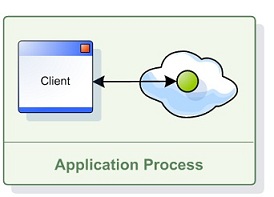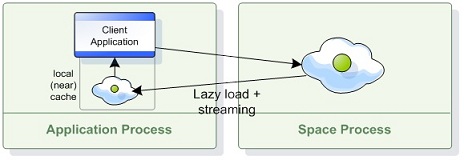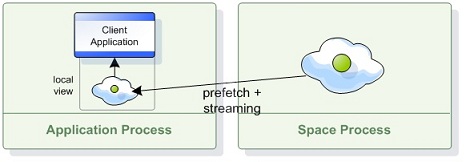Overview
A Space is a logical in-memory service, which can store entries of information. An entry is a domain object; In C#, an entry can be a simple PONO or a SpaceDocument.
When a client connects to a Space, a proxy is created that holds a connection which implements the Space API. All client interaction is performed through this proxy.
The Space is accessed via a programmatic interface which supports the following main functions:
- Write - the semantics of writing a new entry of information into the Space.
- Read - read the contents of a stored entry into the client side.
- Take - get the value from the Space and delete its content.
- Notify - alert when the contents of an entry of interest have registered changes.
A Space proxy is created to interact with the Space. Several configuration parameters are available.
Embedded Space
A client communicating with a an embedded Space performs all its operation via local connection. There is no network overhead when using this approach.

Here is an example how to create an embedded Space. The EmbeddedSpaceFactory is used to configure the Space url:
// Create the ISpaceProxy
ISpaceProxy spaceProxy = new EmbeddedSpaceFactory("mySpace").Create();
<?xml version="1.0" encoding="utf-8" ?>
<configuration>
<configSections>
<section name="ProcessingUnit" type="GigaSpaces.XAP.Configuration.ProcessingUnitConfigurationSection, GigaSpaces.Core"/>
</configSections>
<ProcessingUnit>
<EmbeddedSpaces>
<add Name="mySpace"/>
</EmbeddedSpaces>
</ProcessingUnit>
</configuration>
The Embedded Space can be used in a distributed architecture such as the replicated or partitioned clustered Space:

A simple way to use the embedded Space in a clustered architecture would be by deploying a clustered Space or packaging your application as a Processing Unit and deploy it using the relevant SLA.
Remote Space
A client communicating with a remote Space performs all its operation via a remote connection. The remote Space can be partitioned (with or without backups) or replicated (sync or async replication based).

Here is an example how a client application can create a proxy to interacting with a remote Space:
// Create the ISpaceProxy
ISpaceProxy spaceProxy = new SpaceProxyFactory("mySpace").Create();
<?xml version="1.0" encoding="utf-8" ?>
<configuration>
<configSections>
<section name="ProcessingUnit" type="GigaSpaces.XAP.Configuration.ProcessingUnitConfigurationSection, GigaSpaces.Core"/>
</configSections>
<ProcessingUnit>
<SpaceProxies>
<add Name="mySpace" />
</SpaceProxies>
</ProcessingUnit>
</configuration>
A full description of the Space URL Properties can be found here.
Reconnection
When working with a remote Space, the Space may become unavailable (network problems, processing unit relocation, etc.). For information on how such disruptions are handled and configured refer to Proxy Connectivity.
Local Cache
XAP supports a Local Cache (near cache) configuration. This provides a front-end client side cache that will be used with the Read operations implicitly . The local cache will be loaded on demand or when you perform a Read operation and will be updated implicitly by the Space.

Here is an example for a ISpaceProxy construct with a local cache:
// Create the ISpaceProxy
ISpaceProxy spaceProxy = new SpaceProxyFactory("mySpace").Create();
// Create Local Cache
ISpaceProxy localCache = GigaSpacesFactory.CreateLocalCache(spaceProxy);
Local View
XAP supports a Local View configuration. This provides a front-end client side cache that will be used with any Read or ReadMultiple operations implicitly. The local view will be loaded on start and will be updated implicitly by the Space.

Here is an example for a ISpaceProxy construct with a local cache:
ISpaceProxy spaceProxy = new SpaceProxyFactory("mySpace").Create();
//define names for the localView
const String typeName1 = "com.gigaspaces.Employee";
const String typeName2 = "com.gigaspaces.Address";
//Create an array of views and initialize them with the select criteria
View[] views = new View[] { new View(typeName1, "DepartmentNumber=1"), new View(typeName2, "") };
//Create the local view using the GigaSpacesFactory class.
IReadOnlySpaceProxy localView = GigaSpacesFactory.CreateLocalView(spaceProxy, views);
Security
A secured Space should be configured with a security context so that it can be accessed (when connecting to it remotely). Here is an example of how this can be configured:
SecurityContext securityContext = new SecurityContext ("userName", "password");
// Create the factory
SpaceProxyFactory factory = new SpaceProxyFactory ("mySpaceWithSecurity");
// Set the Cluster Info
factory.Credentials = securityContext;
//create the ISpaceProxy
ISpaceProxy proxy = factory.Create ();
// .......
proxy.Dispose ();
<SpaceProxies>
<add Name="MySpaceWithCustom">
<Properties>
<add Name=" security.username" Value="username"/>
<add Name=" security.password" Value="password"/>
</Properties>
</add>
</SpaceProxies>
The grid components are secured using the Security Administration.
Persistency
When constructing a Space, it is possible to provide Space Persistency extensions using a NHibernate configuration. Here is an example of how it can be defined:
<?xml version="1.0" ?>
<hibernate-configuration xmlns="urn:nhibernate-configuration-2.2" >
<session-factory>
<property name="dialect">NHibernate.Dialect.MySQLDialect</property>
<property name="connection.provider">NHibernate.Connection.DriverConnectionProvider</property>
<property name="connection.driver_class">NHibernate.Driver.MySQLDataDriver</property>
<property name="connection.connection_string">Server=localhost;Database=dotnetpersistency;User ID=root;CharSet=utf8</property>
<!--Disable the writing of all the SQL statments to the console-->
<property name="show_SQL">false</property>
<!--Disabled the validation of your persistent classes, allows using .NET properties and not getters and setters on your fields-->
<property name="use_proxy_validator">false</property>
<!--This will create the tables in the database for your persistent classes according to the mapping file.-->
<!--If the tables are already created this will recreate them and clear the data-->
<property name="hbm2ddl.auto">create</property>
</session-factory>
</hibernate-configuration>
The above example configures both a custom JDBC DataSource and a NHibernate SessionFactory to define and use the GigaSpaces built-in NHibernateSpaceDataSource. The GigaSpaces data source is then injected into the Space construction and causes the Space to use it.
